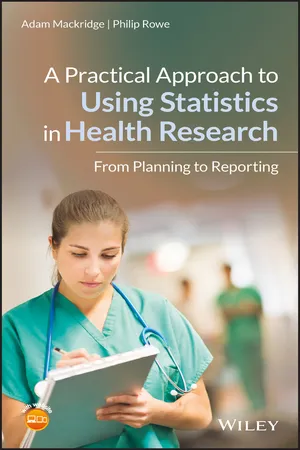
A Practical Approach to Using Statistics in Health Research
From Planning to Reporting
- English
- ePUB (mobile friendly)
- Available on iOS & Android
A Practical Approach to Using Statistics in Health Research
From Planning to Reporting
About this book
A hands-on guide to using statistics in health research, from planning, through analysis, and on to reporting
A Practical Approach to Using Statistics in Health Research offers an easy to use, step-by-step guide for using statistics in health research. The authors use their experience of statistics and health research to explain how statistics fit in to all stages of the research process. They explain how to determine necessary sample sizes, interpret whether there are statistically significant difference in outcomes between groups, and use measured effect sizes to decide whether any changes are large enough to be relevant to professional practice.
The text walks you through how to identify the main outcome measure for your study and the factor which you think may influence that outcome and then determine what type of data will be used to record both of these. It then describes how this information is used to select the most appropriate methods to report and analyze your data. A step-by-step guide on how to use a range of common statistical procedures are then presented in separate chapters. To help you make sure that you are using statistics robustly, the authors also explore topics such as multiple testing and how to check whether measured data follows a normal distribution. Videos showing how to use computer packages to carry out all the various methods mentioned in the book are available on our companion web site. This book:
• Covers statistical aspects of all the stages of health research from planning to final reporting
• Explains how to report statistical planning, how analyses were performed, and the results and conclusion
• Puts the spotlight on consideration of clinical significance and not just statistical significance
• Explains the importance of reporting 95% confidence intervals for effect size
• Includes a systematic guide for selection of statistical tests and uses example data sets and videos to help you understand exactly how to use statistics
Written as an introductory guide to statistics for healthcare professionals, students and lecturers in the fields of pharmacy, nursing, medicine, dentistry, physiotherapy, and occupational therapy, A Practical Approach to Using Statistics in Health Research: From Planning to Reporting is a handy reference that focuses on the application of statistical methods within the health research context.
Frequently asked questions
- Essential is ideal for learners and professionals who enjoy exploring a wide range of subjects. Access the Essential Library with 800,000+ trusted titles and best-sellers across business, personal growth, and the humanities. Includes unlimited reading time and Standard Read Aloud voice.
- Complete: Perfect for advanced learners and researchers needing full, unrestricted access. Unlock 1.4M+ books across hundreds of subjects, including academic and specialized titles. The Complete Plan also includes advanced features like Premium Read Aloud and Research Assistant.
Please note we cannot support devices running on iOS 13 and Android 7 or earlier. Learn more about using the app.
Information
Chapter 1
Introduction
1.1 At Whom is This Book Aimed?
1.2 At What Scale of Project is This Book Aimed?
1.3 Why Might This Book be Useful for You?
- Work out how much data you need to collect in order to provide a reliable answer to the question you have asked (sample size).
- Identify an appropriate measure of effect size, and use that to determine whether any difference you have detected is large enough to be of practical significance (i.e. is a change in public policy or professional practice required?)
- Identify appropriate statistical methods.
- Apply the relevant statistical methods to your data using statistical software, mainly using SPSS.
- Identify which bits of the software output you need to focus on and how to interpret them.
- Determine whether your data indicates statistical significance (i.e. is there adequate evidence that outcomes really do differ between the groups studied?)
- Determine whether your data indicates practical/clinical significance (i.e. is any difference between study groups big enough to be of practical consequence?)
- Make sure any publications you write contain all the necessary statistical details.
1.4 How to Use This Book
| Stage | Actions | Chapters to read |
| 1 | Identify the research question that is to be answere... |
Table of contents
- Cover
- Title Page
- Copyright
- Table of Contents
- About the Companion Website
- Chapter 1: Introduction
- Chapter 2: Data Types
- Chapter 3: Presenting and Summarizing Data
- Chapter 4: Choosing a Statistical Test
- Chapter 5: Multiple Testing
- Chapter 6: Common Issues and Pitfalls
- Chapter 7: Contingency Chi‐Square Test
- Chapter 8: Independent Samples (Two‐Sample) T‐Test
- Chapter 9: Mann–Whitney Test
- Chapter 10: One‐Way Analysis of Variance (ANOVA) – Including Dunnett's and Tukey's Follow Up Tests
- Chapter 11: Kruskal–Wallis
- Chapter 12: McNemar's Test
- Chapter 13: Paired T‐Test
- Chapter 14: Wilcoxon Signed Rank Test
- Chapter 15: Repeated Measures Analysis of Variance
- Chapter 16: Friedman Test
- Chapter 17: Pearson Correlation
- Chapter 18: Spearman Correlation
- Chapter 19: Logistic Regression
- Chapter 20: Cronbach's Alpha
- Glossary
- Videos
- Index
- End User License Agreement